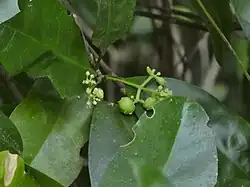Pitaviaster
| Pitaviaster | |
|---|---|

| |
| Flowers and immature fruit | |
| Scientific classification | |
| Kingdom: | Plantae |
| Clade: | Tracheophytes |
| Clade: | Angiosperms |
| Clade: | Eudicots |
| Clade: | Rosids |
| Order: | Sapindales |
| Family: | Rutaceae |
| Subfamily: | Zanthoxyloideae |
| Genus: | T.G.Hartley |
| Species: | P. haplophyllus
|
| Binomial name | |
| Pitaviaster haplophyllus | |
| Synonyms[3] | |
|
Homotypic
Heterotypic
| |
Pitaviaster is a monotypic genus (i.e. a genus that contains only one species) in the flowering plant family Rutaceae. The sole included species is Pitaviaster haplophyllus, commonly known as yellow aspen. It is a tree native to northeastern Queensland.[4]
References
- ^ IUCN SSC Global Tree Specialist Group.; Botanic Gardens Conservation International (BGCI). (2021). "Pitaviaster haplophyllus". IUCN Red List of Threatened Species. 2021: e.T158176159A192496064. doi:10.2305/IUCN.UK.2021-1.RLTS.T158176159A192496064.en. Retrieved 15 December 2023.
- ^ "Pitaviaster haplophyllus". Australian Plant Name Index (APNI). Centre for Australian National Biodiversity Research, Australian Government. Retrieved 8 January 2025.
- ^ a b "Pitaviaster haplophyllus (F.Muell.) T.G.Hartley". Plants of the World Online. Royal Botanic Gardens, Kew. 2025. Retrieved 8 January 2025.
- ^ F.A.Zich; B.P.M.Hyland; T.Whiffen; R.A.Kerrigan (2020). "Pitaviaster haplophyllus". Australian Tropical Rainforest Plants Edition 8 (RFK8). Centre for Australian National Biodiversity Research (CANBR), Australian Government. Retrieved 8 January 2025.
